Written By: James de Lacey, Former Romania Rugby, Kiwi Ferns, Austin MLR S&C
We’ve been told over and over again that “sitting is the new smoking.” While this may be bending of the truth to encourage people to move more, there is no doubt that spending all day sitting isn’t great for your health.
Postural issues and joint pain are just some of the obvious symptoms that rare their head initially. But there are simple and easy exercises you can do at your desk to reduce pain, strengthen your muscles to resist fatigue, and improve your flexibility and mobility. These five exercises will do just that.
Finger Extensions
Flexion of the fingers is a daily repetitive task. That is the motion of making a fist or gripping an object. This could be tapping away on the keyboard or clicking the mouse. This doesn’t even take into account anything you may do at home like scrolling through your phone.
Safe to say, this repetitive use can lead to forearm and elbow pain. But this can be prevented and even relieved through the simple finger extension exercise with a rubber band. This trains the muscles on the top of your forearm which can restore the strength balance between finger flexion and extension.
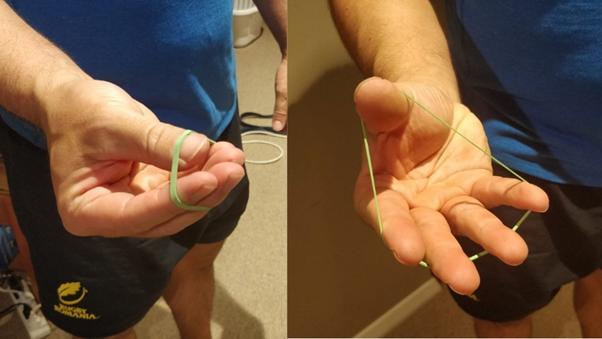
If you’re into building muscle, the finger can balance out your workout routine for bigger forearms. I’ve found the best rubberbands for this are the ones that come with your broccoli (a good excuse to buy more veggies). These rubber bands provide strong resistance and don’t roll down your fingers as you open your hands.
The best thing about this exercise is you can do it while sitting at your desk on the phone or when you take a short break. Because it’s a low load exercise, you can do this multiple times a day every single day.
To start the finger extension, place your thumb and fingertips together. Place the rubber band over the first knuckle just below your fingernails. Spread your fingers just far enough so you don’t lose the band from its knuckle position.
Close the fingers back to the starting position. That is one repetition. I would recommend sets of 20-30 repetitions interspersed through the day.
Band Shoulder Dislocates
I know… dislocate doesn’t sound like an exercise you’d want to do. But bear with me! This exercise is seriously the bomb for opening your shoulders and soon you’ll be walking around your office with your shoulders back and head held high.
Who knows, this newfound power posture could land you new leadership roles or promotions. But I digress. All you need for this is a light strength band. Not a mini band you see Instagram fitness “models” used to perform 100 rep glute workouts.
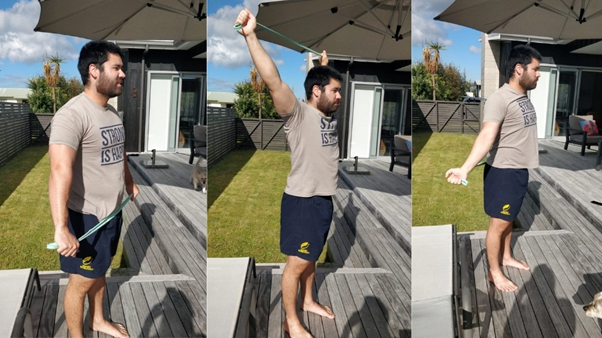
Strength bands are longer and thicker and you can find them at any local sports store or even on Amazon. When starting this exercise, hold the band as wide as possible. You’ll be in for a shock if you try with a close grip!
Keep your arms straight and move the band from in front of you and over your head until the band reaches your lower back. Reverse the motion to return to the starting position. This is one repetition.
As you become more mobile, you can move yours in slightly and work your way in. I would recommend sets of 10-20 repetitions interspersed through your day.
Band Pull Aparts
That’s right. You’re not spending money on a brand that is only used for one exercise. The pull-apart works the muscles of your back. Specifically, the rhomboids and the middle and lower traps. Their main job is to retract the shoulder blades.
These muscles are generally long and weak in those that sit at a desk all day with their arms in front of them. This posture places these muscles in a lengthened position without any load creating an imbalance between the short muscles of the chest and lats and the long muscles of the back.
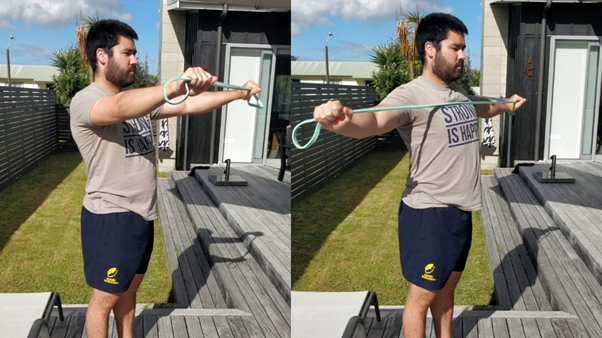
The band pull-apart allows you to strengthen these muscles to restore your posture. Combine this with the band shoulder dislocate and you have a potent combination to unlock your upper body. Hold the band directly in front of your chest with your arms straight.
Take a shoulder-width grip and pull the band apart. You will finish with the band against your chest. At the end position, squeeze your shoulder blades together. This is how you will fully activate the rhomboids.
Slowly return to the starting position. This is one repetition. I would recommend performing 10-20 repetitions interspersed through your day.
4-Way Neck Isometrics
The neck muscles are often the most neglected area when it comes to exercise. Training your neck is vitally important not just for postural reasons, but to relieve neck pain. It’s not a secret sitting at a desk most of the day can place undue strain on your neck.
A stronger neck will be more resistant to fatigue and pain. Further, isometric exercise has been shown to have an analgesic (numbing) effect. Isometric exercise is just a fancy name for creating muscle tension without a change in muscle length. Meaning you will push your head against an immovable object.
So, if you’re suffering from neck pain, then performing an isometric exercise can potentially relieve it. Personally, I’ve found this trick to work far more effective than stretching. Stretching doesn’t provide any relief compared to isometric exercise.
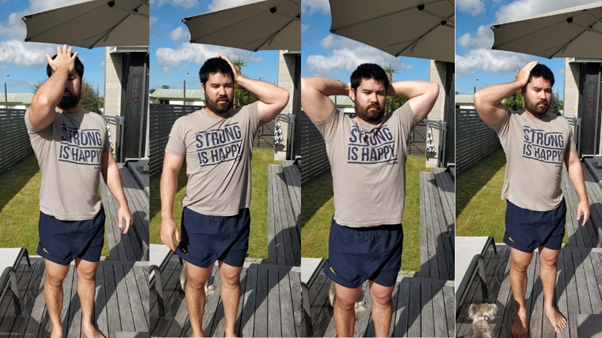
To perform neck isometrics, you can use your hand or you can loop your strength band around your head above your ears. 4-ways refers to the four different directions to perform the isometric contraction. These would be front, back, and to both sides.
When starting with these, don’t push as hard as you can. You will likely cause more problems than you’re fixing. Start at 50-70% effort for 10 seconds in each direction. You can work up to 30-40 seconds at 70-80% effort as you become stronger and more comfortable with the exercise.
I would recommend performing 1-3 sets at the end of your workday or relieving any discomfort or using as needed throughout the day.
Long Duration Isometric Split Squat
Did you know that sitting for prolonged periods of your desk when it is not set up correctly can lead to knee pain? And even if it is set up ergonomically, knee pain can still surface. This is often labeled patella tendonitis and it gets worse for those that already suffer from knee pain.
That is, 50% of those with patellofemoral pain suffer from knee pain when sitting for prolonged periods. But you’re not just sitting at your desk. You’re sitting in traffic for another hour on the drive home.
Then sitting at the dinner table to eat. And finally, sitting on the couch to wind down. No wonder so many of us have short and tight hip flexors that can lead to patellofemoral pain! One of the quadriceps muscles (the rectus femoris) crosses both the hip and the knee joint.
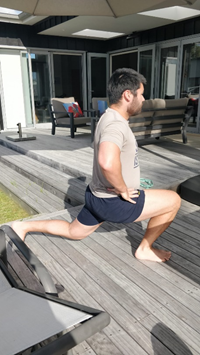
This means it performs both hip flexion and knee extension. Sitting can shorten this muscle which constantly pulls on your patella tendon. Further, not loading the tendon makes it worse as tendons need a load to be healthy.
Cue the long-duration isometric split squat. You might look a little weird to your fellow office colleagues (not as weird as the around the world exercise), but this exercise will simultaneously promote new collagen growth in your patella tendon and lengthen the rectus femoris muscle.
Not to mention the analgesic effect of isometric exercise will help you feel springy and light in your step. I personally use this exercise often especially as part of my workout warm-up. It takes away most patellofemoral pain if I’m suffering from any.
Sounds like a win-win to me. This new collagen growth will restore a dysfunctional tendon and undo the damage caused by prolonged sitting. If you’re familiar with basic strength exercises, all you are doing is pausing at the bottom of a split squat for an extended period.
For those that don’t have such a background, stagger your legs so your feet are very far apart. Lower yourself down as far as you are comfortable with. Support yourself by holding your chair or desk (if it’s sturdy enough).
Ideally, you want your back knee slightly off the floor. Hold this position. You’ll feel a great stretch in the rectus femoris muscle of your back leg and your front leg will feel that “pump” or “burn” sensation from exercise.
Just one set is enough and you want to be able to hold this position for at least 60 seconds. Some absolute nutters can hold this position for 5 minutes. You don’t need to hold the position for this long but I would recommend being able to hold anywhere from 60-90 seconds. Start at 30 seconds if this is difficult.
Your Daily Desk Routine
Incorporate these five exercises into your daily routine at your desk and you’ll be well on your way to improving your overall posture and health. Finger extensions, band shoulder dislocates, and pull apart can be done as often as you like.
Use the neck isometrics at the end of your workday and the isometric split squats can be worked into your lunch break or whenever you have free time at your desk.
- Our Big Kitchen’ (OBK) is a non-profit organization located in Sydney, Australia - April 10, 2023
- Duos CBD, a hemp product E-commerce website - April 10, 2023
- SOFA SPOONING SEX POSITION - April 7, 2023





